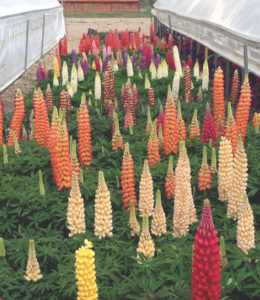Perennials on Display
I am lucky to have grown up in a family business focused on wholesaling perennials, where names like Pseudolanguinosis and Scrophularia were household words! Understandably, to many people who are not avid gardeners, perennials may still be a bit like a foreign language. The majority of shoppers simply have not been exposed to a variety of perennials, but it seems that statistic is changing.

Plants that were once a well-kept secret by perennial gardeners are finally finding their way to the mainstream markets of the everyday consumer thanks to first-year flowering and day-length neutral introductions that are easy for growers to produce.
We all know annuals can pack a powerful punch of color unlike nothing else, especially on retail shelves and storefront displays. But lately the retailers we supply have been asking for plants that have something to give in addition to color … their message is unanimous: “Send us something unique.” Every high-end retailer is looking to set their store apart from the rest and find something distinctive that will stay in their customer’s minds.
Market Testing Varieties
We have had the opportunity to gain some insight from the purchasing team at several high-end retail outlets, grocery stores and garden centers along the Colorado Front Range. With their input, we’ve been able to format a perennial program containing unique varieties that are new to customers, but are easy to produce and timed for a specific sales window.
Last season, we decided to do a bit of a market test with the help of a manager at one of these retailers in Denver, Colorado. We shipped them 1-gallon dahlias in full color, right alongside 1-gallon Asiatic lilies in full color. They were sold at the same exact price, in the same size and color of pot. Though the dahlias were gorgeous with three to five large double flowers per plant, the store called the next day begging for more lilies.
The manager had a hunch that it was the exotic nature of the flowers, coupled with the fragrance and the fact that most of his customers had never been exposed to the option of potted lilies at the typical places they shop. The customer was able to feel like a plant connoisseur for a day and stumble across something unique and exotic that they had never been able to buy at a grocery store before.
There are many annuals that also have this “wow” factor, but it seems perennial plants put on such a burst of color and energy in their shorter flowering window that the show is just that much more spectacular. The tricky part though is to hit this flowering window at its peak and move inventory when it’s perfectly ready — which is why many large growers shy away from them. And if your customer is only taking one or two varieties a week, you had better not miss that peak flowering window!
Creating a Strategy

We have set up the bulk of our program for the larger “marketplace” retailers, such as grocery and hardware stores that only have a storefront to sell product. The concept could also work for retail garden centers that want to create a mass display of color out front with a weekly focus.
We’ve split the varieties into two categories: those that come into full bloom all within the same short window, and those that come into flower gradually and stay in flower over a longer period. Generally, half of our perennial varieties are crops that all come into full bloom at the same time but only last for a short window and are often based on local weather (sun and temperatures). These varieties tend to be the more unique plants with larger eye-catching flowers. Good examples would be the Asiatic Lilies, spring-blooming poppies, digitalis/digiplexis and lupine. What you’re ultimately aiming for is how uniformly the batch blooms together, not the exact date of the bloom.
The other half of the program consists of varieties that come into flower and continue to produce flowers over a long time span. The flowers may be smaller and less unique, but there will constantly be something in bloom to ship. Examples include perennial dianthus, geum, salvia and coreopsis. If they are first- year flowering and day-length neutral varieties, even better!
Basically the concept is to surround the tight bloom windows of the “cool stuff” with other varieties that can hold a week or two before shipping. This method will allow you a bit of flexibility with what is ready for display each week, but also will allow you to grow and ship large quantities of some truly unique and non-commercial varieties that people will love. You will create demand for a beautiful product that consumers never even knew they wanted!


 Video Library
Video Library 




















